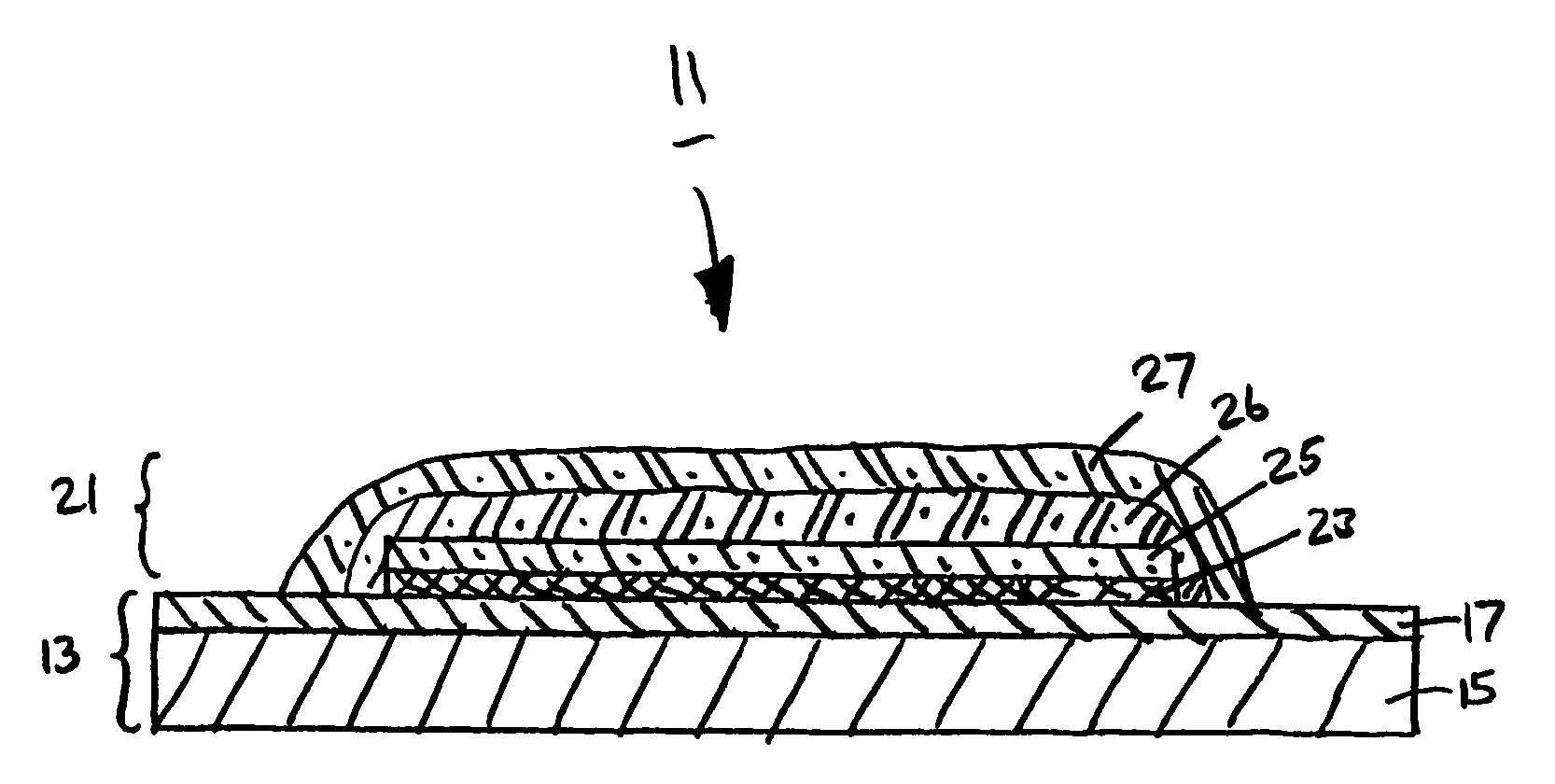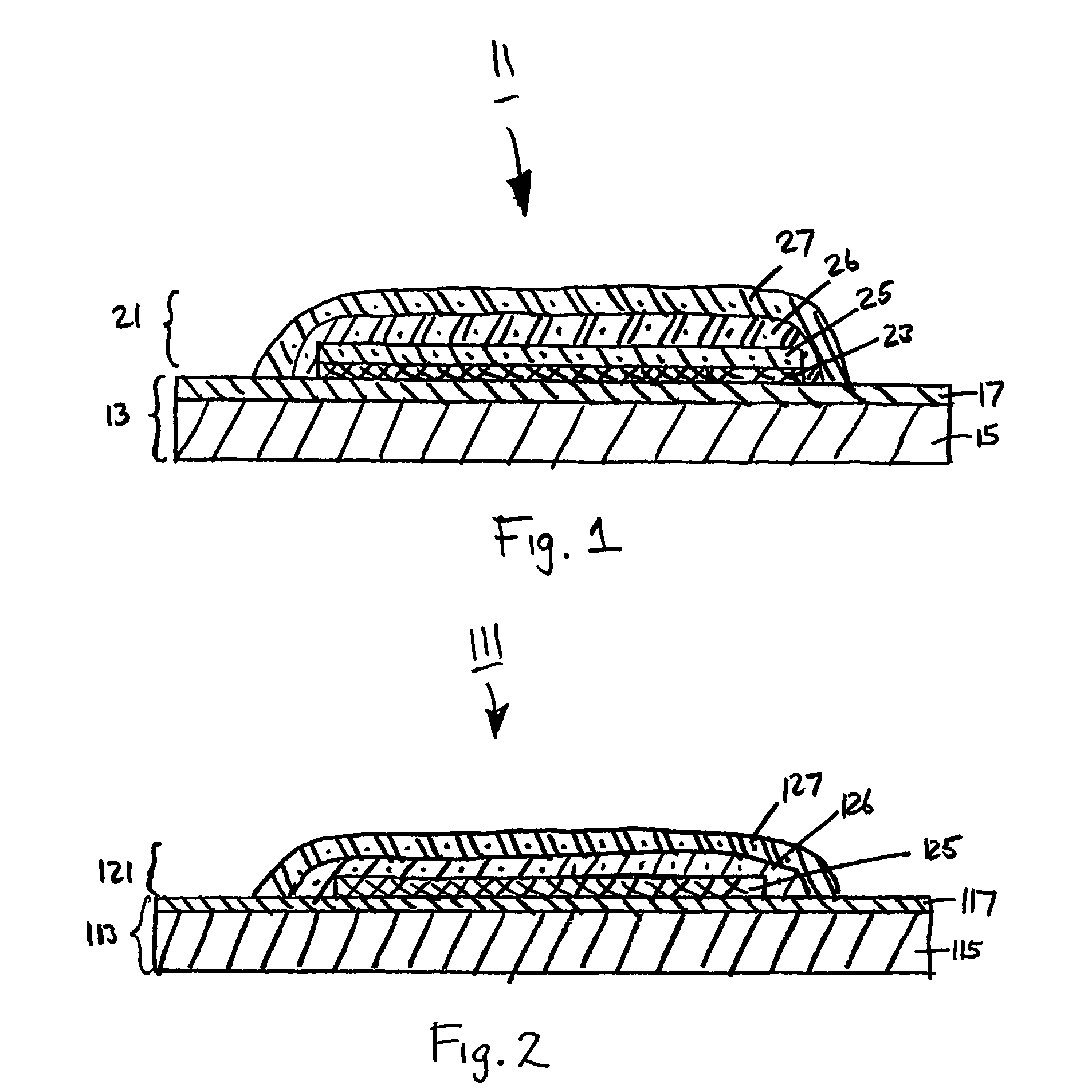Method for labeling fabrics and heat-transfer label well-suited for use in said method cross-reference to related applications
a technology of fabric and label, applied in the field of fabric labeling, can solve the problems of garment itself, clothing damage, wearer irritation, loss of information contained on the label,
- Summary
- Abstract
- Description
- Claims
- Application Information
AI Technical Summary
Benefits of technology
Problems solved by technology
Method used
Image
Examples
first embodiment
[0043] Referring now to FIG. 1, there is shown a schematic section view of a heat-transfer label well-suited for use in labeling articles of fabric, said heat-transfer label being constructed according to the teachings of the present invention and being represented generally by reference numeral 11.
[0044] Label 11 comprises a support portion 13. Support portion 13, in turn, comprises a carrier 15. Carrier 15 may be a paper substrate, a polymer-coated paper substrate, or a polymer film substrate. Preferably, carrier 15 is a polymer film substrate having a glass transition temperature in the range of 60° C. to 250° C. and having a storage modulus in the range of 1.0×1010 dynes / cm2 to 2.0×1010 dynes / cm2 at ambient temperature and a storage modulus in the range of 5.0×107 to 1.5×1010 dynes / cm2 at 100° C. Examples of materials particularly preferred for use as carrier 15 include polyester films, particularly polyethylene terephthalate (PET) films and poly(ethylene 2,6-naphthalene dicarbo...
second embodiment
[0084] Referring now to FIG. 2, there is shown a schematic section view of a heat-transfer label well-suited for use in labeling articles of fabric, said heat-transfer label being constructed according to the teachings of the present invention and being represented generally by reference numeral 111.
[0085] Heat-transfer label 111 comprises a support portion 113, support portion 113 comprising a carrier 115 and a release layer 117. Carrier 115 is identical carrier 15 of label 11, and release layer 117 is identical to release layer 17 of label 11.
[0086] Heat-transfer label 111 also comprises a transfer portion 121 (it being understood that, even though only a single transfer portion 121 is shown on a slightly oversized support portion 113 in FIG. 2, one need not position only one transfer portion 121 per support portion 113, but rather, one may space apart at regular intervals a plurality of identical or different transfer portions 121 on an elongated common web of support portion 11...
third embodiment
[0095] Referring now to FIG. 3, there is shown a schematic section view of a heat-transfer label well-suited for use in labeling articles of fabric, said heat-transfer label being constructed according to the teachings of the present invention and being represented generally by reference numeral 211.
[0096] Heat-transfer label 211 comprises a support portion 213, support portion 213 comprising a carrier 215 and a release layer 217. Carrier 215 is identical to carrier 15 of label 11, and release layer 217 is identical to release layer 17 of label 11.
[0097] Heat-transfer label 211 also comprises a wax layer 219, wax layer 219 overcoating release layer 217 of support portion 213. Wax layer 219, which serves to facilitate the release of the transfer portion to be described below from support portion 213, preferably has a thickness of about 1 to 20 microns, more preferably about 4 to 15 microns, and preferably has a melting point of about 60 to 130° C., more preferably about 80 to 120° C...
PUM
| Property | Measurement | Unit |
|---|---|---|
| surface roughness | aaaaa | aaaaa |
| surface roughness | aaaaa | aaaaa |
| surface roughness | aaaaa | aaaaa |
Abstract
Description
Claims
Application Information
 Login to View More
Login to View More - R&D
- Intellectual Property
- Life Sciences
- Materials
- Tech Scout
- Unparalleled Data Quality
- Higher Quality Content
- 60% Fewer Hallucinations
Browse by: Latest US Patents, China's latest patents, Technical Efficacy Thesaurus, Application Domain, Technology Topic, Popular Technical Reports.
© 2025 PatSnap. All rights reserved.Legal|Privacy policy|Modern Slavery Act Transparency Statement|Sitemap|About US| Contact US: help@patsnap.com



